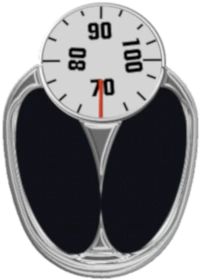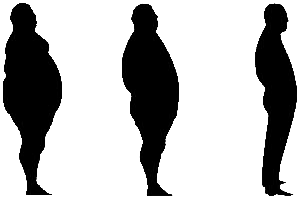Live healthy – Lose weight without diet
 According to the Robert Koch Institute (RKI), 67% of men and 53% of women in Germany are overweight. They have a Body Mass Index (abbr. BMI) of more than 25. Almost 25% of adults are very overweight (obese). If you have a few extra kilos on your ribs, you don't need to worry too much about your health. It is usually more of an aesthetic problem, preventing you from reaching your dream figure for your next beach holiday or your ideal weight. However, more and more people are accumulating dangerous deposits of fat over the course of their lives, which can have a lasting negative impact on their health.
According to the Robert Koch Institute (RKI), 67% of men and 53% of women in Germany are overweight. They have a Body Mass Index (abbr. BMI) of more than 25. Almost 25% of adults are very overweight (obese). If you have a few extra kilos on your ribs, you don't need to worry too much about your health. It is usually more of an aesthetic problem, preventing you from reaching your dream figure for your next beach holiday or your ideal weight. However, more and more people are accumulating dangerous deposits of fat over the course of their lives, which can have a lasting negative impact on their health.
According to the recommendations of the WHO (World Health Organization), people with a BMI of more than 25 are considered to be overweight.
Body Mass Index is calculated from body weight in kilograms (kg) and height in meters (m) using the following formula:
| BMI = | Body weight |
| Body height2 |
What does the BMI mean?
Saying I'm too fat is subjective. Sometimes people of normal weight say they are too fat although their weight is perfectly fine. With my Smart BMI Calculator, you can find out your personal BMI quickly and without obligation. When you calculate your Body Mass Index, you get an initial assessment of whether your body weight is within the normal range for your height or whether you are overweight. The health consequences of being overweight tend to become more common with age. Obesity is a contributing factor to many diseases, such as cardiovascular disease and diabetes.
BMI classification according to the WHO (World Health Organization) scheme.
| less than 16.0 | severe underweight |
| from 16.0 to 16.9 | moderate underweight |
| from 17.0 to 18.4 | slight underweight |
| from 18.5 to 24.9 | normal weight |
| from 25.0 to 29.9 | pre adiposity (moderate overweight) |
| from 30.0 to 34.9 | Grade I obesity (severe overweight) |
| from 35.0 to 39.9 | Grade II obesity (very severe overweight) |
| greater than 40.0 | Grade III obesity (extreme overweight) |
What are the advantages and disadvantages of the BMI?
The Body Mass Index (BMI) is used to estimate a person's body mass (colloquially known as body weight) in relation to their height. Calculating BMI is relatively easy, at least if you use a pocketcalculator. The BMI can be used to quickly assess a person's physical condition. However, the BMI is only a rough guide for an initial assessment, since it doesn't take into account stature or gender. The BMI is also not easy to calculate by mental arithmetic.
For people of average height (about 1.55 to 1.85 metres), Broca's formula is more suitable than BMI for an initial assessment of the physical situation, because the calculation of normal weight using this formula can be easily done using mental arithmetic. For most adults, both values produce similar results. The limutation that Broca's formula is not applicable to very small or very tall people is meaningless for most people. Until the 1980s, Broca's formula was the standard method for calculating normal weight.
The Body Mass Index and the Broca formula are very controversial for accurately assessing obesity because both methods do not take body fat percentage into account. These methods are not suitable for people with a muscular body because muscles weigh more than fat. These algorithms very often misclassify athletes as overweight or even obese. For sporty persons, the two body measurement indexes WHR and WHtR are more useful, since they also take into account the body fat distribution.
For people with an average body size, Broca's formula is a reliable and easy to use tool for identifying overweight.
Normal weight according to Broca's formula
| for women | ||
| Normal weight | = | Body height in cm - 100 - 5% |
| Ideal weight | = | Normal weight - 15% |
for men |
||
| Normal weight | = | Body height in cm - 100 |
| Ideal weight | = | Normal weight - 10% |
With our Broca Calculator you can find out your normal weight without any obligation. The great advantage of the Broca formula is that you see immediately how many kilograms you need to lose to reach your normal weight. All the other body mass indexes are more complicate to use because they are not suitable for mental arithmetic.
What are the alternatives to BMI?
There are a few good alternatives to BMI that also take body fat percentage into account. These are for example:
-
the modern Area Mass Index (abbr. AMI)
The Area Mass Index is the ratio of body mass (body weight) to a person's body surface area. The body surface depends on the stature and gender of the person. -
the Body Adiposity Index (abbr. BAI)
The Body Adiposity Index should actually be more suitable for determining a person's percentage of body fat because the BAI takes into account not only height but also hip circumference. Recent studies have shown that the BAI is less informative than the BMI. -
the Body Shape Index (abbr. BSI)
The Body Shape Index is a further development of the BMI for evaluating a person's body fat percentage. The BSI is said to be better at predicting health risks than the BMI because the particularly harmful abdominal fat is included in the calculation. However, the assessment of the BSI is relatively complicate to use. -
the Waist to Hip Ratio (abbr. WHR)
The Waist to Hip Ratio is the ratio of waist circumference to hip circumference. This quotient is a measure of a person's attractiveness. The WHR value answers the question of where a person's fat deposits are located. The WHR differentiates between apple types and pear types. -
the Waist to Height Ratio (abbr. WHtR)
The Waist to Height Ratio is the ratio of waist circumference to body height. In contrast to the better-known BMI, the WHtR is intended to answer the question of where a person's body fat is located.
Many people try to reduce their weight with diets. There is often a desire to achieve quick success. Many people believe that they reach their desired weight quickly with a strict diet. Although you can lose weight quickly through dieting, the success is usually only temporary for a very short time. After the end of the diet, you quickly gain weight again. Often, you weigh even more than before. If you go on one diet after another for years to keep your weight reasonably stable, this behavior is harmful to your health and leads to the so-called yo-yo effect.
In order to reduce your weight sustainably, a long-term change in your eating habits is necessary. This allows you to achieve and maintain the weight you want and are happy and satisfied with it in the long run.
Proven tips to help you lose weight sustainably
Use a food log and write down everything you eat and drink. Also document the quantity, method of preparation and time of your meals. Also write down the reasons why you eat (hunger, appetite, boredom, grief, anger, etc.) This will give you an overview of your eating habits. This log will clearly show you how much and when you eat. You will find out how and when you can save the most calories.
Check your weight once a week. It is not necessary that you check your body weight every day. Please note that weight differences of up to 2 kg are completely normal.
Take your time with meals and eat slowly. Avoid eating between meals, such as while watching TV or working. This will reduce the likelihood of accidentally eating more calories than you want. Three meals a day are usually enough.
Drink a glass of water before every meal. The best option is non-carbonated mineral water or tap water. If you don't like water, you can also drink other low-calorie drinks.
Losing weight starts with grocery shopping. Never go shopping hungry. It's best to use a shopping list.
Try to lose weight in small steps by slowly but consistently changing your eating habits. Healthy weight loss means 1 to 2 kg per month.
Treat yourself to delicious food. This makes it easier for you to change your eating habits.
Prefer whole grain products. Such products contain a lot of fiber, which fills you up well and keeps you full for a long time.
Fruits and vegetables contain a lot of fiber. Therefore, enjoy steamed vegetables, raw vegetables and fresh fruits every day. This means you are well supplied with vitamins, minerals and trace elements.
Two or three portions of meat weighing 125 grams each and around 150 grams of sausage per week are enough. Try eating vegetarian too.
Enjoy delicious fish once or twice every week.
Use fat sparingly. Spread butter or margarine thinly on bread and use teaspoons or tablespoons to measure the right amount of oil needed to prepare your food.
Colorful food is not only beautiful for your eyes, but also good for your health. By colorful we mean the natural color of the foods, not the use of artificial colors.
Olive oil is ideal for salads and rapeseed oil for frying.
Drink at least 2 liters of fluid every day, water is best.
Try to avoid Alcohol and limit your consumption of sweets, cakes and pastries.
Light products are not defined under food law. Products that are advertised as light may have less calories than conventional foods. But that doesn't have to be true.
Diet products do not always have less fat and fewer calories than conventional foods. Often only the sugar in these products is reduced or replaced by sweeteners such as saccharin, sucralose or aspartame. These sweeteners are suspected of damaging the intestinal flora. The fat is usually not reduced in diet products.
Physical activity is just as important as changing your eating habits in order to permanently reduce your weight. You will achieve the best results with endurance sports such as swimming, cycling, walking, jogging or brisk walking. After the physical development training, three times 30 minutes per week are sufficient.

When fat deposits are really harmful to health
We all know that being overweight is bad for our health and it makes us sick. The BMI is a simple number that tells us whether we are overweight or not. Simple relationships like this are always popular because they are easy to remember and easy to share. But the fact that obesity is not so simple is only slowly coming to the surface.
Experts know already for many years that it is not possible to make reliable statements about a person's health without taking other data into account. It is not just a question of how much fat is present, but also how the fat tissue is distributed throughout the body.
For normal weight adults, fat tissue, consisting of so-called adipocytes (white and brown fat cells), makes up about 12% of body weight. For overweight or obese people, the fat tissue can account for well over 50% of body weight.